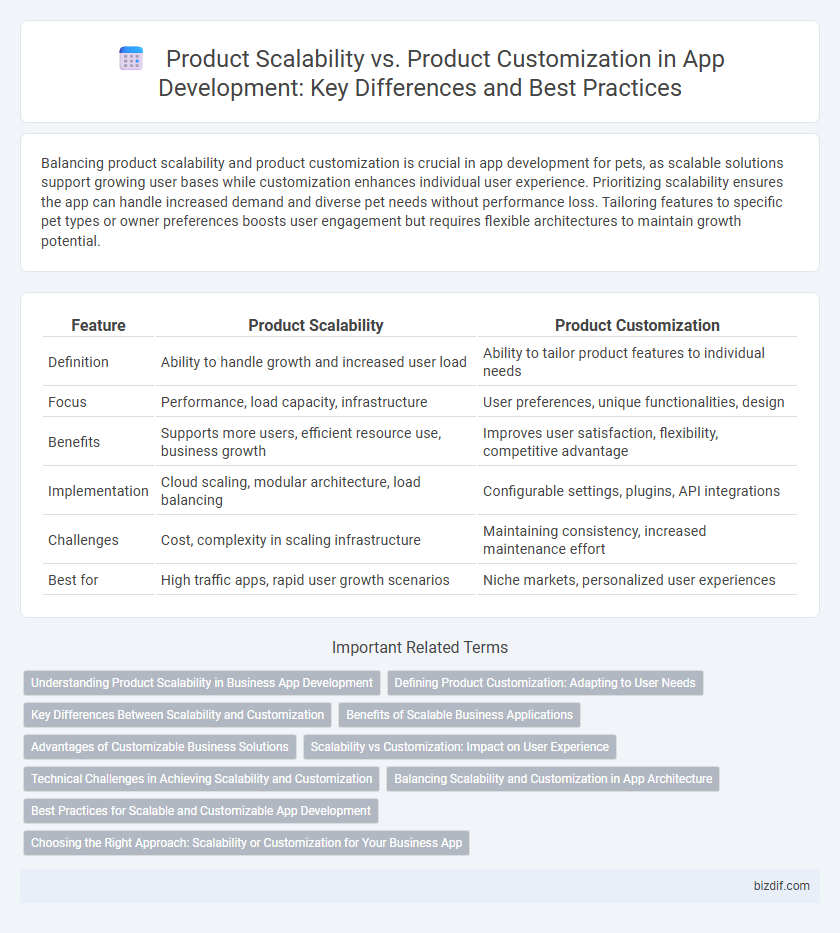Balancing product scalability and product customization is crucial in app development for pets, as scalable solutions support growing user bases while customization enhances individual user experience. Prioritizing scalability ensures the app can handle increased demand and diverse pet needs without performance loss. Tailoring features to specific pet types or owner preferences boosts user engagement but requires flexible architectures to maintain growth potential.
Table of Comparison
| Feature | Product Scalability | Product Customization |
|---|---|---|
| Definition | Ability to handle growth and increased user load | Ability to tailor product features to individual needs |
| Focus | Performance, load capacity, infrastructure | User preferences, unique functionalities, design |
| Benefits | Supports more users, efficient resource use, business growth | Improves user satisfaction, flexibility, competitive advantage |
| Implementation | Cloud scaling, modular architecture, load balancing | Configurable settings, plugins, API integrations |
| Challenges | Cost, complexity in scaling infrastructure | Maintaining consistency, increased maintenance effort |
| Best for | High traffic apps, rapid user growth scenarios | Niche markets, personalized user experiences |
Understanding Product Scalability in Business App Development
Product scalability in business app development refers to the ability of an application to handle increased workloads and user growth without compromising performance or user experience. It involves optimizing architecture, employing cloud infrastructure, and implementing efficient database management to support seamless expansion. Prioritizing scalability ensures long-term sustainability, reduces downtime, and accommodates future feature integrations beyond initial customization needs.
Defining Product Customization: Adapting to User Needs
Product customization in app development involves tailoring features and interfaces to meet diverse user preferences and specific industry requirements, enhancing user satisfaction and engagement. This approach allows dynamic adjustments based on real-time user data and behavior analytics, improving personalization without compromising core functionality. Balancing customization with scalability ensures seamless performance as the user base grows while maintaining flexible adaptation to evolving demands.
Key Differences Between Scalability and Customization
Product scalability refers to an app's capacity to handle increased user load and data volume without performance degradation, while product customization focuses on tailoring features and interfaces to meet specific user needs. Scalability often involves optimizing architecture for growth, such as cloud services and modular design, whereas customization requires flexible code structures allowing personalized options and settings. Understanding these key differences helps developers balance robust infrastructure with adaptable user experiences to ensure both efficiency and satisfaction.
Benefits of Scalable Business Applications
Scalable business applications enable seamless growth by efficiently handling increased user demand and transaction volumes without compromising performance. These applications foster cost-effective expansion, reducing the need for frequent overhauls and allowing businesses to adapt quickly to market changes. Prioritizing scalability supports long-term sustainability and ensures consistent user experience amid evolving business needs.
Advantages of Customizable Business Solutions
Customizable business solutions enable app development to effectively address unique user requirements, enhancing customer satisfaction and retention. These tailored solutions facilitate seamless integration with existing systems, improving operational efficiency and reducing time-to-market for new features. By allowing flexibility in design and functionality, customizable apps support scalable growth while adapting to evolving business needs.
Scalability vs Customization: Impact on User Experience
Product scalability ensures a seamless user experience by efficiently managing increased demand and maintaining consistent performance across diverse devices and user bases. Customization enhances user engagement by adapting features and interfaces to individual preferences, fostering a personalized interaction. Balancing scalability with customization is essential to deliver a reliable yet tailored app experience that satisfies broad audiences while addressing specific user needs.
Technical Challenges in Achieving Scalability and Customization
Achieving product scalability in app development requires addressing technical challenges such as maintaining performance under increased user load and ensuring database scalability through efficient indexing and caching strategies. Customization introduces complexity in codebase management, demanding modular architecture and dynamic configuration to support diverse user requirements without compromising system stability. Balancing scalability and customization necessitates robust API design and cloud-based infrastructure to enable seamless feature scalability and personalized user experiences simultaneously.
Balancing Scalability and Customization in App Architecture
Balancing scalability and customization in app architecture requires designing modular components that enable flexible feature adjustments while maintaining system performance under increasing user loads. Leveraging microservices architecture allows independent scaling of specific modules without disrupting customized user experiences. Employing API-driven development enhances adaptability, ensuring that both product growth and unique user demands are seamlessly addressed.
Best Practices for Scalable and Customizable App Development
Scalable app development prioritizes modular architecture and cloud-native infrastructure, ensuring the product can handle increased user load without performance degradation. Customization focuses on flexible user interfaces and configurable features that adapt to individual user needs while maintaining code maintainability. Best practices include leveraging microservices, API-driven design, and continuous integration workflows to balance scalability and customization efficiently.
Choosing the Right Approach: Scalability or Customization for Your Business App
Choosing between product scalability and customization in app development depends on your business goals and target audience. Scalability ensures the app can handle increasing users and data efficiently, supporting long-term growth without compromising performance. Customization allows tailored features and user experiences, meeting specific needs but may limit expansion and increase maintenance complexity.
Product scalability vs Product customization Infographic

 bizdif.com
bizdif.com